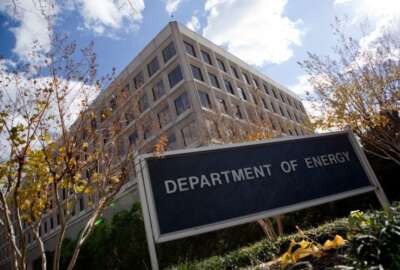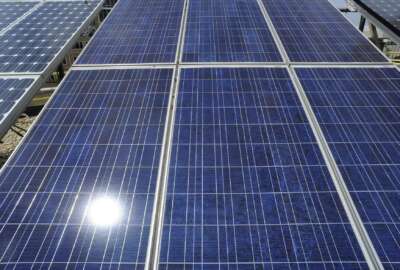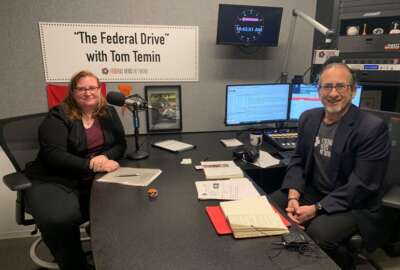Yet another avenue for trying to make federal buildings go green
One of the initiatives from the Energy Department to try and make that happen is a $6 million award to certain national laboratories to expand the use of geothe...
Best listening experience is on Chrome, Firefox or Safari. Subscribe to Federal Drive’s daily audio interviews on Apple Podcasts or PodcastOne.
The Biden administration has made it an objective to decarbonize federal operations in the near future. One of the initiatives from the Energy Department to try and make that happen is a $6 million award to certain national laboratories to expand the use of geothermal heating and cooling at federal sites. To learn more about this plan, and just how much this technology could help the White House reach its goal. Eric White for the Federal Drive with Tom Temin spoke to Alexis McKittrick, the DOE’s geothermal technology offices program manager.
Interview transcript:
Alexis McKittrick: The backgrounds here is the federal government is really looking to lead by example in the renewable energy space, including deploying renewable energy technologies, and decarbonizing our own infrastructure. Out of over 7,000 U.S. facilities, federal facilities, about 450 of those campuses make up 75% of the federal government’s energy use. And so from a geothermal heating and cooling perspective, this project is looking to convert even if we can only convert a couple of those large campuses to geothermal, we’ll have the opportunity to significantly decarbonize the federal infrastructure, and increase resilience and energy security for key federal sites in the process.
Eric White: So would only certain federal sites be able to do this? And I guess I can parlay that into the question of how does geothermal energy work? It’s been a word that’s been tossed around, but I would like to kill the buzziness of it now and have you actually explained it to me.
Alexis McKittrick: Sure, will do. Let’s tackle that first, the technology piece, and then we’ll jump into what sites might be candidates here. So geothermal resources are essentially reservoirs of hot water and rock that exists at varying temperatures and varying depths in the Earth’s surface. So it is the heat beneath our feet, if you will. For geothermal heating and cooling, we’re looking at a couple of potential uses of that subsurface heat. Geothermal heat pumps or ground source heat pumps are I would say kind of the most commonly known geothermal heating and cooling technology. They’re deployed about 2.5 million different residences in the U.S. actually use geothermal heat pumps now, and a number of districts and community systems use them in network as well. And how they operate is they have essentially an underground component and an above-ground component. In the underground component, you have piping that is run underground, that is utilizing the relatively constant ambient temperature in the shallow subsurface. So think about 65 or 70 degrees Fahrenheit, right? That shallow subsurface temperature of about 70 degrees Fahrenheit allows you to provide cooling in the summer, as well as heating in the winter, by doing heat exchange with that shallow subsurface. And by shallow I mean kind of tens of feet to potentially hundreds of feet underground for that piping. And then as you’re working a fluid through that piping and doing that heat exchange, essentially on the surface, you have a geothermal heat pump that allows that fluid to transfer the heating or cooling to the building air and then you have kind of a traditional HVAC system and each back blower that then is moving that air of course through the building to supply the heating or cooling. So one I think thing I’d like to demystify is the idea that geothermal is only a heating solution. Because I would say honestly, the most commonly known geothermal applications actually year-round heating and cooling in the form of these geothermal heat pumps.
Eric White: Yeah I think it’s because you think of geothermal first thought that comes to my mind is a hot spring or something like that. So everyone thinks that, but yeah, the aspect of cooling is something that yeah, it’s not touched on a lot.
Alexis McKittrick: And if I may, there are what are called geothermal direct use systems that do use deeper geothermal resources that are hotter. So I mentioned that 70 degrees Fahrenheit-ish for geothermal heat pumps, you can go thousands of feet into the subsurface and tap hotter temperatures, so 100 to 300 degrees Fahrenheit, but then you take that warm fluid via a well bring it up to the surface and use heat exchange primarily for heating. And that can be larger district or community systems like the one that we see in Boise, for example. That I think supplies hot water to 90 different buildings in Boise, Idaho. And then the cooled water after you’re finished with it can be completely returned to the earth in a closed system. So it’s a really great application, but that is the kind that is more geothermal heating focused. And I would be remiss if I didn’t mention that geothermal can also be used for electricity generation as well. So, there are geothermal power plants, within the U.S. right now that are producing clean, renewable electricity to our grid. And we’re primarily focused on heating and cooling today, but want to make sure that that powerful application, geothermal is out there as well.
Eric White: All right, you’ve made the sale. So what is the geographic limitations of geothermal that you were about to get into?
Alexis McKittrick: So what’s great about geothermal heating and cooling is it really is a 50-state solution, particularly when you’re talking about geothermal heat pumps. They operate actually in all 50 states in the U.S. now. And we are increasingly seeing this emerging trend of these networked systems that are kind of called district scale or community scale, geothermal heating and cooling systems that have emerged primarily on college campuses in the U.S., but are starting to emerge more in the private sector and communities as well. And these systems essentially use kind of common networked underground loops. Either one loop leveraging that constant temperature we were talking about, for individual heat pumps, or two loops, one that is primarily for warm and one premium really for cold, that can essentially provide heating and cooling to an entire campus. When you combine this with, again, some fields essentially, of piping infrastructure that can run underground, sort of in mass and provide that larger scale heating and cooling effect that similar to the heat pump, one that I was mentioning earlier, just scaled up to a district or campus scale. So that’s one thing that we really think is powerful about this technology is that it really can be applied anywhere in the United States as a renewable energy solution, and in particular, for ability heating and cooling.
Eric White: So is it just the infrastructure costs is the reason why we don’t see it in more places? Or was the technology just not there yet to make it feasible?
Alexis McKittrick: Sure. So capital costs associated with these systems have historically been been one of the barriers. I think we’re seeing a couple of really interesting and unique solutions emerge to that, in particular, some industry partners that are looking at potentially partnering with utilities, for example, as the space grows and emerges, and as I mentioned, this is a trend that is is catching on in the U.S. So I really think Eric, that over the next kind of five to 10 years, we’re going to see some different business models that recognize the utility of these systems and the broad applicability of them, and help reduce that overall kind of capital costs associated with these systems, because in addition to being 50 states, they reduce emissions compared to fossil fuel, they’re reducing the load on the the electric grid, and in particular, be able to reduce peak load times. And they can be combined with other renewable energy technologies, like solar, for example. So geothermal heat pumps do draw small line of electricity. But if say you have solar panels that can supply that electricity, you can essentially create a complete renewable energy system, which is a powerful message. And something that we want to, like I said, lead by example, within the federal government, which kind of brings us back to this award in particular, which is focused on applying these systems to federal infrastructure.
Eric White: Yeah, that’s a nice segue into the research aspect of things. What can you tell me about the work that the Energy Department’s own national labs are doing? And maybe you know, if there’s anything else that you want to add in, you know, from the industry side that you’re seeing as well?
Alexis McKittrick: Sure. So I’ll first say that the driver for this work, and what we’re calling the Federal Geothermal Partnership Initiative or Fed Geo Partnership is supporting Executive Order 14057, which is the executive order asking the federal government to to decarbonize its infrastructure. We’re looking to achieve carbon-pollution-free electricity sector by 2035, and net zero emissions economywide no later than 2050. In order to do that the federal government needs to lead by example, in this space, and again, looking to deploy, us this Fed Geo Partnership’s initiative to specifically deploy geothermal heating and cooling technologies to federal sites. This is a partnership that the Geothermal Technologies Office, which is the group that I work in, partners with the Federal Energy Management Program, or FEMP. And they’re the part of Department of Energy that’s responsible for tracking renewable energy installations at federal facilities. Through our work with them and their their deployment focus work, we identified a need for technical assistance at federal sites to consider geothermal heating and cooling to do the exploration that designed the site testing the characterization on sites that will help these federal sites determine if they’re a candidate for geothermal heating and cooling. And so we’ve recently made an award, as you said to our national laboratories, and in particular, led by Oak Ridge National Laboratory. They’re going to partner with a number of other labs that have different expertise related to building codes to design of these systems, to understanding loads on the grids, and the impact that these systems can have within the federal space. And they’re going to work to do that site characterization and design work at the different federal sites that we’ll look to move forward with. In addition to labs, though, I want to stress that what’s really great about this award in this project is that Oakridge is also working with two universities that have experienced in this space. And they brought in the International Ground Source Heat Pump Association, or IGSHPA, which is essentially the nonprofit that is supporting private sector in this in this space. And so we’re going to have a lot of private sector expertise that we can leverage as part of these systems and these designs, in addition to the combined power of our national laboratory. So it’s a pretty powerful award.
Eric White: All right. And last question, yes or no, that EO is framed in the Energy Department right now. And it’s planted on the wall.
Alexis McKittrick: You know, if I had been into the office more often, I probably wouldn’t be able to verify. But I imagine that it is for sure. We all are, as I said, really excited for the federal government to lead by example and the Department of Energy has a really big role in that.
Copyright © 2024 Federal News Network. All rights reserved. This website is not intended for users located within the European Economic Area.
Tom Temin is host of the Federal Drive and has been providing insight on federal technology and management issues for more than 30 years.
Follow @tteminWFED






